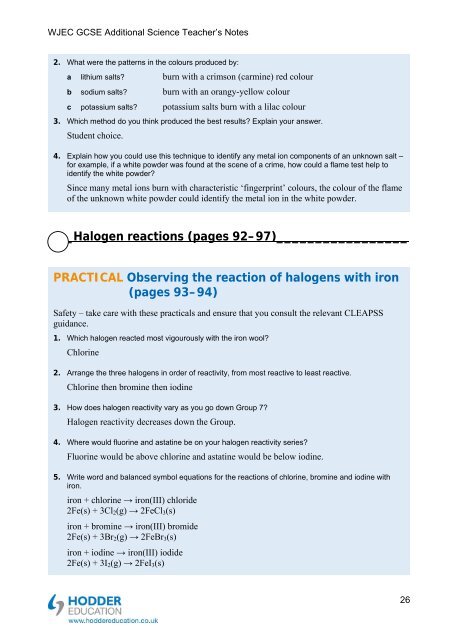Teacher's notes and answers to questions in the book - Hodder Plus ...
Teacher's notes and answers to questions in the book - Hodder Plus ...
Teacher's notes and answers to questions in the book - Hodder Plus ...
Create successful ePaper yourself
Turn your PDF publications into a flip-book with our unique Google optimized e-Paper software.
WJEC GCSE Additional Science Teacher’s Notes<br />
2. What were <strong>the</strong> patterns <strong>in</strong> <strong>the</strong> colours produced by:<br />
a lithium salts burn with a crimson (carm<strong>in</strong>e) red colour<br />
b sodium salts burn with an orangy-yellow colour<br />
c potassium salts potassium salts burn with a lilac colour<br />
3. Which method do you th<strong>in</strong>k produced <strong>the</strong> best results Expla<strong>in</strong> your answer.<br />
Student choice.<br />
4. Expla<strong>in</strong> how you could use this technique <strong>to</strong> identify any metal ion components of an unknown salt –<br />
for example, if a white powder was found at <strong>the</strong> scene of a crime, how could a flame test help <strong>to</strong><br />
identify <strong>the</strong> white powder<br />
S<strong>in</strong>ce many metal ions burn with characteristic ‘f<strong>in</strong>gerpr<strong>in</strong>t’ colours, <strong>the</strong> colour of <strong>the</strong> flame<br />
of <strong>the</strong> unknown white powder could identify <strong>the</strong> metal ion <strong>in</strong> <strong>the</strong> white powder.<br />
_Halogen reactions (pages 92–97)_________________<br />
PRACTICAL Observ<strong>in</strong>g <strong>the</strong> reaction of halogens with iron<br />
(pages 93–94)<br />
Safety – take care with <strong>the</strong>se practicals <strong>and</strong> ensure that you consult <strong>the</strong> relevant CLEAPSS<br />
guidance.<br />
1. Which halogen reacted most vigourously with <strong>the</strong> iron wool<br />
Chlor<strong>in</strong>e<br />
2. Arrange <strong>the</strong> three halogens <strong>in</strong> order of reactivity, from most reactive <strong>to</strong> least reactive.<br />
Chlor<strong>in</strong>e <strong>the</strong>n brom<strong>in</strong>e <strong>the</strong>n iod<strong>in</strong>e<br />
3. How does halogen reactivity vary as you go down Group 7<br />
Halogen reactivity decreases down <strong>the</strong> Group.<br />
4. Where would fluor<strong>in</strong>e <strong>and</strong> astat<strong>in</strong>e be on your halogen reactivity series<br />
Fluor<strong>in</strong>e would be above chlor<strong>in</strong>e <strong>and</strong> astat<strong>in</strong>e would be below iod<strong>in</strong>e.<br />
5. Write word <strong>and</strong> balanced symbol equations for <strong>the</strong> reactions of chlor<strong>in</strong>e, brom<strong>in</strong>e <strong>and</strong> iod<strong>in</strong>e with<br />
iron.<br />
iron + chlor<strong>in</strong>e → iron(III) chloride<br />
2Fe(s) + 3Cl 2 (g) → 2FeCl 3 (s)<br />
iron + brom<strong>in</strong>e → iron(III) bromide<br />
2Fe(s) + 3Br 2 (g) → 2FeBr 3 (s)<br />
iron + iod<strong>in</strong>e → iron(III) iodide<br />
2Fe(s) + 3I 2 (g) → 2FeI 3 (s)<br />
26

















